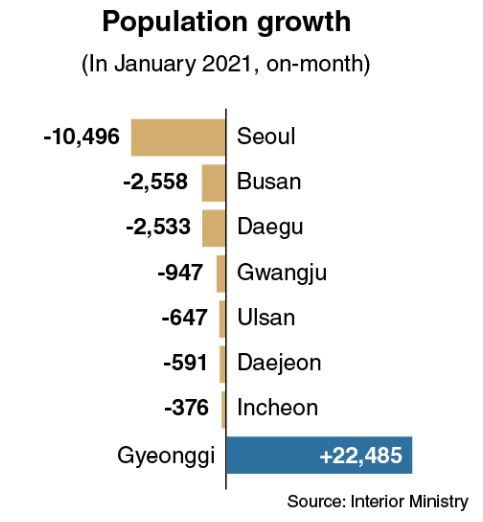
The photo shows the interior of a flag carrier departing for Tokyo from Gimpo International Airport in Seoul in 1968, when Korea conducted a nationwide family planning campaign in response to a historic increase in its population between the mid-1950s and mid-1960s. (National Archives of Korea)
SEJONG -- The downhill trajectory in South Korea’s demographic figures, which started in December 2019, continued last month as more cities and provinces posted negative population growth.
According to the Ministry of Interior and Safety, the nation’s population declined by 3,091 on-month to 51.825 million in January 2021. In December 2018 the figure stood at 51.826 million.
Furthermore, 15 of the country’s 17 major cities and provinces saw growth in the minus range, with only Sejong and Gyeonggi Province posting positive figures.
Seoul experienced the fastest population decline in the nation: The number of its residents dropped by 10,496 on-month to 9.65 million. Given the 9.73 million figure posted in January 2020, the capital’s population slid by more than 75,000 people in only a year.
Busan was next, losing 2,558 residents, followed by Daegu, which lost 2,533 residents. South Gyeongsang Province saw its population decline by 1,820 people, North Gyeongsang Province by 1,783 people, North Jeolla Province by 1,356 people and South Chungcheong Province by 1,192 people.
The other areas that experienced negative population growth were Incheon, Daejeon, Gwangju, Ulsan, Gangwon Province, North Chungcheong Province, South Jeolla Province and Jeju Province.
In contrast, Gyeonggi Province gained 22,485 residents and Sejong gained 2,040 residents.
Gyeonggi is continually absorbing households as families move from Seoul amid skyrocketing apartment prices in the capital, while Sejong is still expanding as the administrative city launched in July 2012.
Seoul was only 71.8 percent as populous as neighboring Gyeonggi Province, where at least 1 in 4 Koreans reside and whose population stands at 13.44 million.
Across the nation, deaths outnumbered births with 25,799 deaths and 21,882 births during the month. The total fertility rate is at a record low at fewer than one child per woman over a lifetime.
While the nationwide gap between deaths and births was 3,917, other factors offset it somewhat, limiting the population decrease to 3,091 people. These included citizenship changes -- Koreans renouncing their citizenship and foreigners acquiring Korean citizenship -- and changes to the long-term residency status of Koreans overseas and foreign nationals here.
Relative to the population as a whole, the proportion of people under the age of 15 posted an all-time low of 12.1 percent last month. The youth population stood at 13.7 percent of the total five years earlier in January 2016 and 15.8 percent a decade earlier in January 2011.
On the contrary, the elderly population -- those aged 65 or over -- sharply climbed from 10.9 percent of the total in January 2011 to 13.2 percent in January 2016 and reached a record high of 16.5 percent in January 2021.
Further, 40.8 percent of the population, or 21.16 million people, were aged 50 or over as of last month. Octogenarians, nonagenarians and centenarians respectively numbered 1.74 million, 255,030 and 22,120.
Among all age groups, those in their 50s accounted for the highest percentage of the total at 8.64 million. In contrast, there were only 3.94 million children under 10 and 4.78 million young people aged between 10 and 19.
In addition, those in their 60s (6.794 million) outnumbered those in their 20s (6.792 million) and inched closer to the number of people in their 30s (6.85 million).
The ministry data also showed that Korea, an aged society according to the stipulations of the United Nations, saw the people’s average age reach a historic high of 43.3 (42.1 for men and 44.4 for women).
This contrasted with the average ages of 40.6 (39.4 for men and 41.7 for women) in January 2016 and 38.2 (37.0 for men and 39.4 for women) in January 2011.
By Kim Yon-se (
kys@heraldcorp.com)




![[KH Explains] No more 'Michael' at Kakao Games](http://res.heraldm.com/phpwas/restmb_idxmake.php?idx=645&simg=/content/image/2024/04/28/20240428050183_0.jpg&u=20240428180321)


